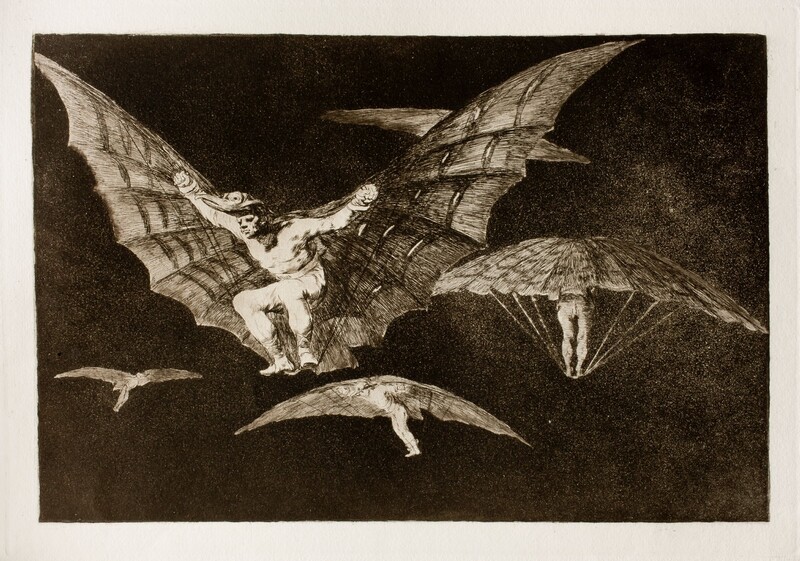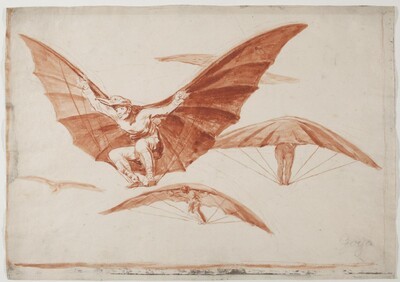- Cronología
- 1815 - 1816
- Dimensiones
- 245 x 358 mm
- Técnica y soporte
- Aguafuerte, aguatinta y punta seca
- Reconocimiento de la autoría de Goya
- Documented work
- Ficha: realización/revisión
- 22 Aug 2021 / 05 Jun 2023
- Inventario
- 225
See Femenine folly.
The state proof before the aquatint in the Lazaro Galdiano Foundation in Madrid has the handwritten number 4 in the upper left-hand corner. Another state proof is known to be bound in the album of Juan Agustín Ceán Bermúdez's Bullfighting (British Museum, London) with the number 34 and the title A way of flying and Way of Flying and The Winged Man's Way of Being Able to Fly.
Men fly on mechanical devices with large bat-like wings, which they operate with their hands and feet by means of ropes. On their skulls they wear a large bird's head, which serves as a prow orientation or simply as a symbol to emulate the freedom of birds. The group is made up of five flying men. One of them, in the foreground, bends his legs to set the contraption in motion. The rest are distributed in the space with great harmony and proportion.
The characters fly in an immense, boundless night sky, soaring away into mysterious depths and heights. In this way, man is liberated and moves through infinite space with great freedom, an achievement achieved by human effort. Through the use of reason, man has invented an ingenuity that allows him to fly and conquer space where he achieves complete freedom, fulfilling his long-held dream of soaring the skies. Leonardo da Vinci had already envisaged this with mechanical devices very similar to those presented by Goya.
It is thought that this print was never intended by Goya as part of the Follies series, as it was bound in an album of Bullfighting that the painter gave to Ceán Bermúdez. Furthermore, there are other indications that it was not intended as an integral part of the series. It manifests a positive vision that is not typical of the Follies, showing man as responsible for the achievement of flight. This optimism is most evident in the state proofs without aquatint, in which the dark sky is not yet present. It is possible that Goya devised the daytime print, as the preparatory drawing for it is. When the aquatint was applied to the San Fernando Royal Academy of Fine Arts edition in 1864, its appearance became much more sombre and in keeping with the spirit of the series, to which it would have been incorporated at a later date. The fact that the manuscript title on the state proofs does not include the word follie, as is usual in the series, also seems to exclude the initial belonging of this print to the series.
-
Etchings by Francosco GoyaJohannesburgoJohannesburgo1974
-
Grabados de Goya: colección propiedad de la Biblioteca Nacional, que se conserva en su Gabinete deCasa de la Amistad de MoscúMoscow1979exhibition displayed from January 18th to 31st 1979
-
Goya. Das Zeitalter der Revolucionen. Kunst um 1800 (1980 – 1981)Hamburger KunsthalleHamburg1980cat. 162
-
Goya y el espíritu de la IlustraciónMuseo Nacional del PradoMadrid1988from October 6th to December 18th 1988. Exhibited also at Museum of Fine Arts, Boston, January 18th to March 26th 1989; The Metropolitan Museum of Art, Nueva York, May 9th to July 16th 1989, Madrid curator Manuela B. Mena Marqués, scientific directors Alfonso E. Pérez Sánchez and Eleanor A. Sayre
-
Ydioma universal: Goya en la Biblioteca NacionalBiblioteca NacionalMadrid1996from September 19th to December 15th 1996cat. 299
-
Francisco Goya. Sein leben im spiegel der graphik. Fuendetodos 1746-1828 Bordeaux. 1746-1996Galerie KornfeldBern1996from November 21st 1996 to January 1997
-
Goya. 250 AniversarioMuseo Nacional del PradoMadrid1996consultant editor Juan J. Luna. From March 29th to June 2nd 1996
-
Goya grabadorMuseo del Grabado Español ContemporáneoMarbella1996from March 8th to May 5th 1996
-
Zaragoza1996
-
London1997
-
1999
-
Madrid1999
-
Schlaf der Vernunft. Original radierungen von Francisco de GoyaMunich2000
-
Goya en tiempos de guerraMuseo Nacional del PradoMadrid2008consultant editor Manuela B. Mena Marqués, from April 14th to July 13th 2008cat. 180
-
Bilbao2012cat. 180
-
Goya luces y sombrasCaixaForumBarcelona2012consultant editors José Manuel Matilla and Manuela B. Marqués. From March 16th to June 24th 2012cat. 74
-
Goya et la modernitéPinacothèque de ParisParís2013from October 11st 2013 to March 16th 2014cat. 213
-
Goya: Order and disorderMuseum of Fine ArtsBoston2014cat. 216
-
Madrid2017
-
Agen2019cat. 67
-
Madrid2019cat. 157
-
OxfordBruno Cassirer1964p. 395, cat. 260
-
Vie et ouvre de Francisco de GoyaParísOffice du livre1970p. 326, cat. 1591
-
Catálogo de las estampas de Goya en la Biblioteca NacionalMadridMinisterio de Educación y Cultura, Biblioteca Nacional1996p. 241, cat. 387-388
-
MadridReal Academia de Bellas Artes de San Fernando y Calcografía Nacional1996pp. 107 y 111, cat. 13 y 33
-
Roma Edizioni de Luca2000pp. 136-137, cat. 45
-
MadridMuseo Nacional y Ediciones El Viso2008pp. 484-485, cat. 180
-
MadridConsejo Superior de Investigaciones Científicas2010pp. 210-211
-
ParísPinacoteca de París2013p. 274
-
Goya: Order & DisorderBostonMuseum of Fine Arts Boston Publications2014pp. 310-315
-
Goya. In the Norton Simon MuseumPasadenaNorton Simon Museum2016pp. 204-211
-
ZaragozaGobierno de Aragón y Fundación Bancaria Ibercaja2017p. 271
-
AgenSnoeck2019p. 122
-
MadridMuseo Nacional del Prado2019p. 245

